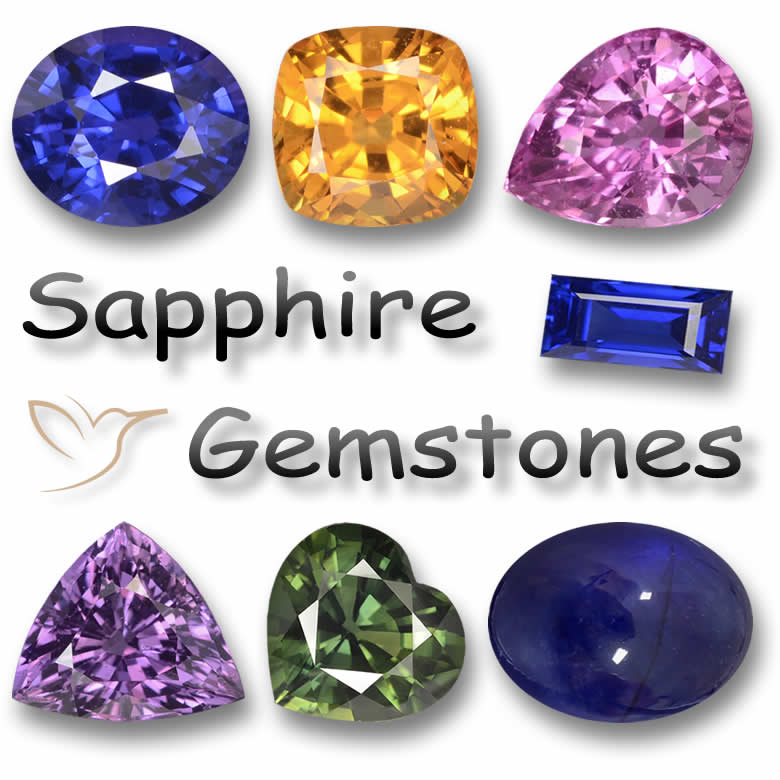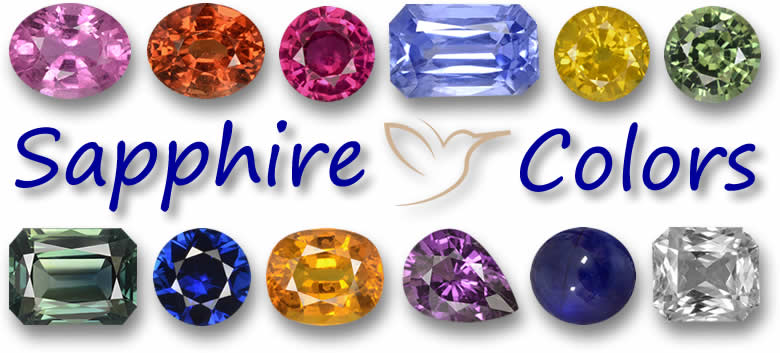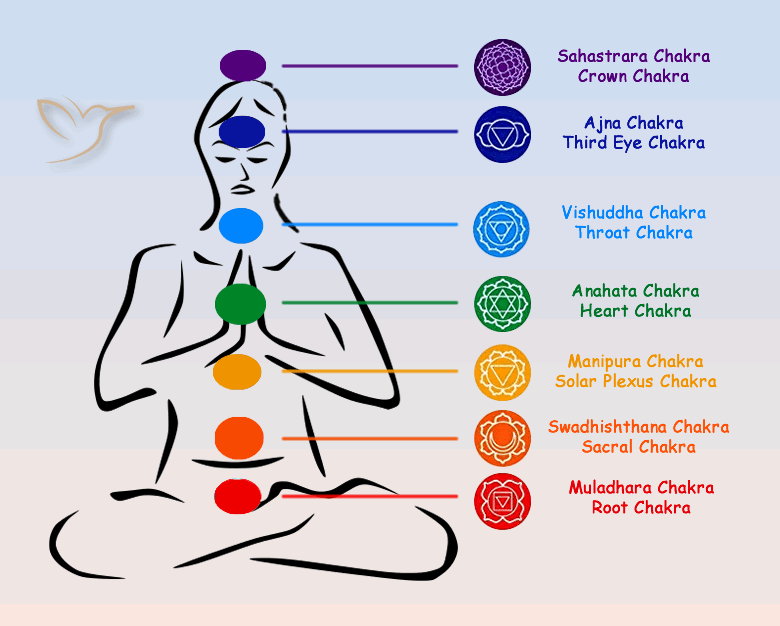Sapphire Gemstone: What is Sapphire? Sapphire Color and more

Sapphire Stone: An Overview
Sapphire. Just saying or reading the word conjures up an immediate vision of a deep blue gemstone perhaps adorning the hand of a princess, prominent on a royal crown or catching the eye on a sultan's turban. The diamond may be the king of the gemstones but surely it is the royal blue sapphire that captures hearts above all others.
As a sibling to the ruby, the sapphire shares its value, appeal, and scarcity. They are both members of the corundum family with rubies being red and sapphires covering all the other colors. Sapphires are famously blue, but yellow, green, or purple versions are objects of true wonder.
Our sapphire for sale collection includes almost all available sapphire colors. You'll be amazed by the color spectrum offered.
Sapphire Colors

Sapphires are a variety of the mineral corundum, as are the equally famous and valuable rubies. Rubies make up the red side of the family, while sapphires include all other colors - the famous blue as well as pink, green, orange, and yellow. There are also black and colorless sapphires.
Blue sapphires are simply called 'sapphires,' while the other colors usually need a color prefix, like pink sapphires or yellow sapphires. Sometimes the colored versions are known as fancy sapphires, though this doesn't apply to the colorless, black, or blue types.
Blue Sapphires: A Symbol of Serenity and Depth
Among the spectrum of sapphire colors, blue sapphires are perhaps the most recognized and revered. Their deep blue shades evoke feelings of tranquility, loyalty, and wisdom. Often chosen for engagement rings, they symbolize trust and commitment, making them a popular choice for couples worldwide.
A name worth noting is the Padparadscha Sapphire.
Padparadscha Sapphire is a blend of pink and orange, resulting in a peachy or salmon-colored stone named after a delicately colored lotus flower. Padparadscha sapphires are possibly the rarest of all, very much desired and highly priced, but the demand is such that they don't often come onto the open market.

All other factors being equal, pretty much all colored gemstones are valued based on their color - a combination of hue, tone, and saturation. A nice even color throughout the gemstone is very much desired, with a deep color tone without being too dark to appreciate. Sapphires are no different, but it's the blues that are valued more than other colors, and a blue described as cornflower blue or sometimes Kashmir blue is the best.
A rare phenomenon in the world of gems is the ability to change color when viewed under different types of light. Some sapphires have this ability, usually appearing bluish in daylight and reddish under electric lights.
Then there are bi-colored sapphires, showing two different colors under the same lighting conditions. The better examples gradually change color across the stone when viewed from the top.
The colors of sapphires (and rubies) are caused by the presence of minute impurities within the base corundum mineral. Trace amounts of chromium, iron, or titanium in various proportions can create all the colors we see in these valuable gemstones.
Sapphire Species
Sapphires are all types of corundum with trace element impurities responsible for their various colors. Corundum is separated simply by color: all red corundum are rubies (this can spark debates over where a light red ruby becomes a pink sapphire), and all other colors are sapphires.
List of sapphire varieties - sapphire colors
- Blue Sapphire or just Sapphire
All sapphires that can be considered blue in color - Yellow Sapphire
Canary yellow to almost honey colored - Orange Sapphire
The deepest yellows to nearly red - Green Sapphire
All the green hues - Pink Sapphire
From light pink to almost red - White Sapphire
Clear or white sapphires have no impurities and so are completely colorless - Black Sapphire
Black or very dark blues or grays - Fancy Sapphire
The yellow, orange, green, pink, purple hues - Padparadscha Sapphire
Salmon or peach colored hues, named after the color of a particular lotus flower - Star Sapphire
Display star beams or rays across the surface of a cabochon-cut sapphire. - Color Change Sapphire
Color changing when viewed under different light sources
Sapphires are divided into yellow sapphires, green sapphires, and so on, although blue sapphires tend to be just referred to as 'sapphires,' and sometimes the colored versions are called fancy sapphires.
There are star sapphires, so called because of rutile inclusions that display star-like patterns on the surface of a cabochon-cut sapphire. Particularly colored sapphires in salmon or sunset hues can be called Padparadscha sapphires and are exceptionally rare. Some sapphires can change color in different lighting conditions and are known as color-change sapphires.
What is the spiritual meaning of Sapphire?
When discussing the spiritual meaning of sapphire, keep a couple of things in mind. First, ancient scholars and mystics didn't have the modern equipment we use today to classify gemstones. It's highly likely that what was sometimes identified in historical texts as sapphires might have been lapis lazuli or another revered blue gemstone. This doesn't diminish the significance of either the mystics or the crystals, but it's worth considering.
Second, sapphires come in various colors, and these colors affect different aspects of spiritual and physical well-being.
The traditional blue sapphire represents loyalty, wisdom, truth, sincerity, and faithfulness - both in religious matters and personal relationships - which is why they make such popular engagement rings.
The individual colors can offer additional benefits.
Orange sapphires can be empowering for creative people like writers, singers, painters, potters, and poets. They fire up your vitality, boost sexual energy and virility, and enhance fertility.
Just along the color spectrum, yellow sapphires share some attributes with orange ones, bringing the power of the sun into your life along with wisdom, prosperity, and positivity.
Green sapphires are the traveler's stone, keeping you safe on journeys and opening your mind to the beauties of the world around you.
Black sapphires are the working person's talisman - whether you're seeking a job, planning a career change, or hoping for a promotion.
White or colorless sapphires connect us to higher divinities and guides, helping overcome feelings of lost faith.
Purple sapphires are perfect for those facing a forced lifestyle change. Maybe a recent health scare has prompted a new fitness regime; purple sapphires can provide the determination to stick with it.
The colors of sapphires are caused by mineral impurities within the stone - for example, titanium and iron create the blue in blue sapphires. These elements can also influence a person spiritually: iron strengthens and energizes the body, titanium calms stress and anxiety, and chromium encourages independence.
Historically, sapphires are known as gems of wisdom and prophecy, a sign of divine support, and an aid in resisting black magic and psychic attacks. They safeguard honor and chastity, uncover fraud and betrayal, and offer protection against plague, poison, and disease. However, as a righteous gemstone, it would become dull if possessed by an irreligious or intemperate person.
Sapphires and the Chakras

Chakras are the energy centers in your body, also known as Qi or Prana. There are seven chakras throughout the body, each influencing a particular physical, emotional, or mental state, and each has an associated color: Crown (purple), Third Eye (indigo), Throat (blue), Heart (green), Solar Plexus (yellow), Sacral (orange), and Root (red). Depending on the dominant color in your sapphire gemstone, it will influence a specific chakra.
Traditionally, sapphires most influence the Throat and Third Eye chakras because they are predominantly and famously blue. Physically, they can heal the voice and throat area; spiritually, they open lines of communication or heal broken connections.
Sapphire in Feng Shui: Harmonizing Energy
In the realm of Feng Shui, sapphires play a unique role in balancing energies. Their calming blue tones are believed to soothe the soul and bring clarity to the mind. By placing a sapphire gemstone in specific areas of a living space, practitioners believe it can usher in serenity, focus, and a flow of positive energy.
Health benefits of Sapphire
Sapphires are powerful gemstones, so your whole physical being can benefit from their presence, but some areas are particularly influenced. Linked to the Throat chakra, they address problems around the neck and throat, including swollen glands and thyroid issues, as well as communication problems involving the vocal cords and voice box. Eye infections and even poor eyesight can improve with sapphires.
Emotionally, sapphire crystals can free us from negative emotions, remedy neurosis, depression, and even psychotic episodes. They lighten our mood and restore emotional balance.
We're often asked how to use gemstones for spiritual or health benefits. While we're not experts, we've gained some experience. Wearing the gemstone as jewelry is the easiest way for it to influence your body. Certain stones and colors connect to different body parts - for example, sapphires link to the throat and third eye chakras, so a pendant, necklace, or earrings would be ideal.
Alternatively, carry them in your purse or pocket as a touchstone. Hold crystals or place them on your lap while meditating. Simply lay down with crystals on your body, aligned with chakra points if possible. Put them in the bath (check if the stone is water-safe). Decorate your home with them - some boost work environments on your desk, others aid relaxation in the living room.
Sapphires can be discharged and charged using sea salt. Mix with water or use dry. For salt water, add a tablespoon of sea salt to cold water, soak the sapphires overnight. For dry, bury in salt overnight.
Sapphire Price
A few years ago, a 392-carat blue sapphire sold for $17 million - the most expensive sapphire ever. Sapphires are one of the premium four gemstones, competing with diamonds, emeralds, and rubies, and prices reflect this.
Sapphire Price List - Updated 2025 |
||
|
Color / Type |
Weight range |
Price range / USD |
|---|---|---|
|
Blue |
1ct + |
$300 - $3,000/ct |
|
Blue |
2ct + |
$600 - $6,000/ct |
|
Pink |
1ct + |
$400 - $2,000/ct |
|
Pink |
2ct + |
$1,500 - $6,000/ct |
|
Fancy Colored |
1ct + |
$100 - $2,000/ct |
|
Fancy Colored |
2ct + |
$200 - $4,000/ct |
|
Untreated |
1ct + |
$1,000 - $25,000/ct |
|
Star (untreated) |
1ct + |
$100 - $2,000/ct |
|
Black Star (treated) |
1ct + |
$30 - $100/ct |
|
Blue Star (treated) |
1ct + |
$25 - $100/ct |
The famed Kashmir blue sapphires are the most valuable and only getting more expensive. They can fetch $10,000 to $30,000 per carat, and with mines in a contested war zone between India and Pakistan nearly exhausted, prices will rise.
Padparadscha sapphires can approach Kashmir prices, occasionally reaching $20,000 per carat. Strict experts say they come only from Sri Lanka, but similar stones appear in Tanzania and Madagascar; Sri Lankan ones top the market.
What sets a sapphire's price? Consider the 4 Cs: color, clarity, cut, and carat. For colored gems, color is key.
Assess hue, tone, and saturation. Hue is the color and undertones, tone is light to dark, saturation is vividness.
Sapphires come in many colors, but blue is most valuable. A perfect blue: deep cornflower to violet-blue hue, no green undertone; medium-dark tone not affecting brightness; vivid, even saturation. Other colors follow similar pricing.
Clarity refers to inclusions. Clearer stones are more valuable. Sapphires often have inclusions; flawless ones might be synthetic or treated.
Some inclusions enhance, like silk in Kashmir sapphires for a velvety look, or rutile for star sapphires.
Cut shapes the rough stone. A great cut enhances beauty; a bad one ruins it.
Sapphires are cut to minimize inclusions, maximize color and luster. Lighter tones cut deeper, darker shallower.
Common shapes: oval, round, cushion, emerald. Star sapphires as cabochons. Cuts should be symmetrical, table centered, flashing color.
Sapphires can show pleochroism - different colors by angle. Cutters maximize dominant color.
Carat weight: Sapphires are rare; over 5 carats rarer. Top 1-2ct: $1,200-$2,000/ct; 3-4ct: $2,500-$4,000/ct due to rarity. Larger: sky's the limit.
Treatments affect price. Untreated, vivid large sapphires are priceless; good-color untreated demand high prices. Lab synthetics are high quality but less valued.
For those looking to invest in sapphire, consider factors like rarity and market trends.
How much is a 1 carat Sapphire?
One common term in gem trading is 'carat.' Before modern scales, traders used carob seeds as weights - about 200 milligrams each, now the standard carat.
See our sapphire price table hereSo, what does 1 carat (0.2 grams) of sapphire cost? It depends on factors, but for a top-quality blue, it could be $300 to $3,000, and prices per carat rise with size.
Gem densities vary: 1ct sapphire smaller than diamond, larger than emerald. Buy by size (mm) for sapphires to know what you get. Generally, 1ct sapphire is about 6mm across.
Can I afford a blue sapphire? With prices starting lower for treated stones, many can.
Are Sapphires more expensive than Diamonds?

Sapphires are very rare - much rarer than diamonds - yet diamonds are often more expensive.
This is due to controlled diamond supply - few supreme stones released yearly - and strong marketing. Occasionally, a special sapphire outvalues a diamond.
Sapphire Gemstone History
Sapphires appear in biblical texts and ancient Greek, Persian, and Sanskrit writings. Referenced in the Bible as throne decoration, Ten Commandments material, Aaron's breastplate, and Jerusalem's foundations. Ancient Greeks wore them for protection; Persians said the sky reflected a giant sapphire.
Before modern science, distinguishing gems was hard; many 'sapphires' might have been lapis lazuli.
The name sapphire comes via Latin (sapphirus) and Old French (saphir), mainly from Ancient Greek sáppheiros, meaning 'blue stone.'
It may trace to Sanskrit Sanipriya, 'dark-colored stone' or precious to Saturn.
Sri Lanka is the oldest known source, along with India and Burma (Myanmar).
Buddhists from northern India arrived in Sri Lanka around 500 BC, finding gems in rivers. They fashioned jewelry, traded abroad, reaching Persia and Greece. King Solomon sent Sri Lankan gems to the Queen of Sheba.
Where are sapphires found?

Sri Lanka, India, and Myanmar were ancient sources, then Kashmir in Pakistan. Finest Kashmir and Burmese show superb color and clarity untreated. Limited Burmese resources shifted focus to rubies.
Thailand yields golden-yellow (Mekong whiskey), Cambodia and Vietnam nearby. In Africa: Tanzania, Kenya, Mozambique, Madagascar, Nigeria.
As of 2007, Madagascar leads production, but Sri Lanka steady for fine blue.
Sri Lanka and Madagascar offer wide colors; Madagascar's deposits discovered 1998.
Australia produces 70% world's blue; Montana untreated blues.
Many sapphires cut in Chanthaburi, Thailand. Mining there mostly done.
Kashmir Sapphires: The Crème De La Crème
From Kashmir's snowy regions, these velvety blue gems - like a tranquil evening sky - are pinnacle quality. Rare, sought-after, they epitomize luxury.
For more on sources for sapphire gems, including the Golden Triangle sapphires from Thailand, Cambodia, and Vietnam.
How are Sapphires formed?

Sapphire forms from corundum - aluminum and oxygen - under immense pressure and heat deep in Earth for millions years. Liquid seeps into rock cracks, cools into crystals, usually colorless.
Trace minerals (1%) alter color: iron+titanium for blue, chromium for red (rubies). Mixes create other colors.
Crystals small in rocks; extraction expensive, often breaks them. Weathering frees gems over time; most mined from stream sediments.
Are there synthetic Sapphires?
Yes, as valuable gems, synthetics exist. Melt process: aluminum oxide melted, minerals added for color, hardens. Flame fusion by Auguste Verneuil early 1900s, produced tons yearly.
Solution process: seed crystal grows under heat/pressure, faster than nature. Labs produce uniform, novel combos; disclose as man-made.
But what is a natural sapphire? It's one mined from the earth, untreated or treated but not lab-created.
Can Sapphires be treated?
All gems treated by cutting/polishing. Further: heating, painting, dyeing, resins, oiling, chemicals. Opinions vary on ethics, but disclose to buyers.
About 90% sapphires heat-treated for market. Ancient: blowpipes over 1100°C. Now: controlled ovens.
Example: Sri Lanka's geuda - cloudy, worthless - heat to cornflower blue, melting inclusions.
Traditional heat accepted: no additions, natural attributes improve.
Controversial: titanium diffusion (surface color), flux healing (adds minerals), beryllium diffusion (color change, heals cracks).
We at GemSelect disclose treatments.
To determine sapphire treatment, consult a gemologist or lab report.
What jewelry is Sapphire suitable for?

Sapphire rates 9 on Mohs, like ruby. Suitable for any jewelry, daily wear without chipping/scratching. Rivals diamond (10).
Cut any shape, worn anywhere; limits: budget, imagination. Common: ovals, cushions; cutters maximize sparkle/color.
Match alloy: white gold/platinum modern; rose/yellow gold vintage. Colors match favorites.
Since Diana's ring (now Kate's), blues popular for engagement. Strong for daily, any jewelry.
See examples of sapphires set into custom jewelry.
Did you know? Interesting facts about Sapphires.
- The largest faceted sapphire is the Blue Giant of the Orient
486.52 carats from Sri Lanka, discovered 1907, rough over 600 carats. - The biggest star sapphire is the Star of Adam
Found 2016 in Sri Lanka, over 1400 carats, worth up to $300 million. - The greatest sapphire is 61,500 carats
Carved, sold $50 million. From Madagascar, carved by Alessio Boschi depicting mankind's achievements: Pyramids, Great Wall, icons like Da Vinci, Confucius, Einstein. - Sapphire is the gift for 5th and 45th anniversaries - two chances to buy for your love.
- The famous ring: Diana's 12 carat oval sapphire engagement ring, Charles proposed; William used for Kate 2010.
- 'Sapphire' from Greek 'sappheiros,' originally lapis lazuli.
- Shah Jahan's Peacock Throne: seven years build, peacocks with sapphire tails.
- Burton's talisman: large star sapphire brought luck; survived attacks, entered Mecca. Gravestone: "Who seemed to bear a charm 'gainst spear or knife or bullet..."
- September birthstone - perfect gift idea.
- Explore the Bismarck Sapphire Necklace and The Heart of the Ocean Sapphire Necklace for more famous pieces.
- Learn about the most valuable sapphires in history.
How to care for Sapphires.
Hardness means no special care, but protect softer gems. Store separate in fabric-lined box or cloth bags.
Durable for bumps, but avoid abuse. Remove for activities, cleaning, gardening.
Clean with warm soapy water, soft brush. Ultrasonic ok unless filled; avoid if unsure.
For valuable, professional clean/check.
Careful: ultrasonics can fracture or loosen settings. No steam - avoid high temps.
How can you tell a real sapphire?

Certified from reputable dealer best. Get report unless good return policy.
Unscrupulous may pass synthetics/fakes. Check: natural, synthetic, imitation? Honest dealers disclose.
For natural: inclusions - flawless might be synthetic/glass.
Scratch: hard, only diamond scratches; knife/key won't.
Imitations: dyed glass/crystal. Rub on surface - if streaks, fake.
Synthetic vs natural: hard to tell; synthetics flawless, even color. Gemologist needed.
Price: too cheap for prime? Probably not real.
Not complete guide, but helps.
GemSelect offers reports from AIGS or BGL Lab.
What is so special about a Sapphire?
Sapphire is one of original four precious gemstones with diamond, emerald, ruby; others semi-precious.
Though terms less used, shows esteem. Owning one: rarest natural object, formed millions years, faceted art. Most expensive blue (besides rare blue diamond), coveted millennia, outstanding hardness, luster, color.
Can Sapphire change color?
Yes! Some show dramatic change under lights; rare color-change sapphire. Common: blue daylight to purple incandescent; yellow, green, pink possible.
Transparent, few inclusions, eye-clean. Price: clarity, size, color intensity, change degree.
How can you tell a good quality Sapphire?
Buy from respected dealer with return policy; get checked.
We've covered 4Cs, sources, treatments, genuineness. Assuming disclosure true, decide: like look? Matches skin? Suitable jewelry? Right size/shape?
Answering these, you'll know if right for you.
Sapphire - Gemological Properties
|
Chemical Formula: |
Al2O3, Aluminum oxide |
|
Crystal Structure: |
Trigonal, double pointed, barrel-shaped, hexagonal pyramids, tabloid shaped |
|
Color: |
Blue, colorless, pink, orange, yellow, green, purple, black |
|
Hardness: |
9.00 on the Mohs scale |
|
Refractive Index: |
1.762 - 1.788 |
|
Density: |
3.95 to 4.03 |
|
Cleavage: |
None |
|
Transparency: |
Transparent to opaque |
|
Double Refraction or Birefringence: |
0.008 |
|
Luster: |
Vitreous |
|
Fluorescence: |
Blue: none; colorless: orange-yellow, violet |
Frequently Asked Questions
What is a sapphire?
A sapphire is a precious gemstone variety of the mineral corundum, known for its stunning colors, especially blue, and high hardness.
What are the different colors of sapphires?
Sapphires come in blue, pink, yellow, orange, green, purple, black, and colorless varieties, with blue being the most famous.
What is the spiritual meaning of sapphire?
Sapphires symbolize loyalty, wisdom, truth, and faithfulness, with different colors offering additional benefits like creativity or protection.
How much does a sapphire cost?
Prices vary widely based on color, size, and quality, ranging from $25 per carat for treated stones to over $25,000 for untreated premium ones.
Where are sapphires found?
Major sources include Sri Lanka, Madagascar, Myanmar, Kashmir, Thailand, Australia, and various African countries like Tanzania and Mozambique.
Are sapphires treated?
Yes, most are heat-treated to enhance color and clarity; other treatments like diffusion exist, but should be disclosed.
How do I care for my sapphire?
Clean with warm soapy water and a soft brush; store separately to avoid scratching other gems; avoid ultrasonics if treated.
How can I tell if a sapphire is real?
Check for inclusions, hardness (can't be scratched easily), and get a certification; synthetics are flawless and even-colored.
Can sapphires change color?
Yes, some rare color-change sapphires shift hues under different lights, like blue to purple.
What makes a sapphire special?
It's one of the four precious gemstones, rare, durable, and historically coveted by royalty for its beauty and symbolism.

